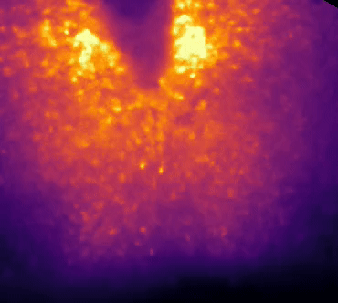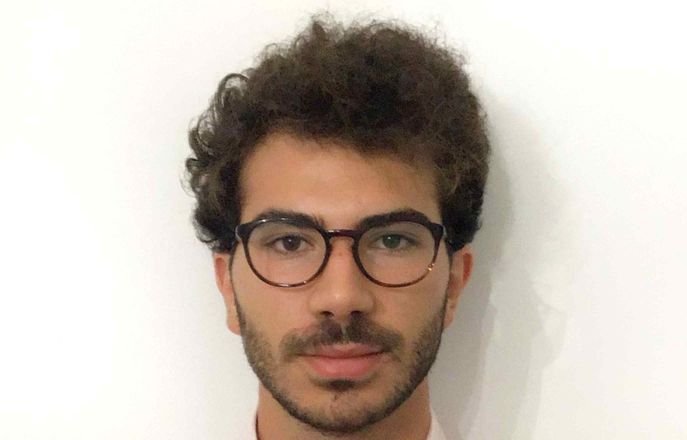Research
Mechanisms of Circadian Dysfunction in Ageing and Neurodegeneration
Circadian clocks anticipate predictable variations of the environment prompted by the solar cycle to optimise our metabolism, physiology and behaviour and synchronise them to the external world. Energy consumption, inflammatory processes and sleep/wake cycles are just a few key examples of the complex orchestration executed by our inner body clock, day by day.
 Figure i, left - recording of circadian rhythms of intracellular calcium in neurons of the suprachiasmatic nucleus
Figure i, left - recording of circadian rhythms of intracellular calcium in neurons of the suprachiasmatic nucleus
Although the molecular mechanisms underlying clock function and embedded in our cells and tissues are well characterised, we know little about how their activities are more widely coordinated amongst different tissues and organs. This is especially important in the brain, whereby activities of glial and neuronal populations have been found to be oppositely coordinated during day and night with their fine reciprocal tuning essential for circadian time-keeping.*
Breakage of mutual relationships amongst astrocytes, neurons and microglia and other brain cells emerges as a common leitmotif in neurodegenerative conditions, such as Alzheimer’s Disease**. Therefore, we aim to investigate their cell-type specific intracellular clock mechanisms and their mutual daily relationship, to understand how glia and neurons work together to ensure the circadian tempo in the brain.
Our circadian system is constantly and unnaturally challenged in modern society: 75% of the world population is exposed to light at night and up to 40% of the work force is engaged in shift work. Therefore, we aim to model the effects of such modern life-style and chrono-disruptive events, (e.g. jet-lag, sleep deprivation and shift work) on these internal brain clock mechanisms and their contributions to early neurodegenerative processes and cognitive decline.
Finally, can we molecularly manipulate these inter(c)locked, cell-type specific circadian mechanisms to “lock” brain function in a favourable state, with the aim of preventing and/ or delaying onset of neurodegenerative conditions?
In the Brancaccio laboratory, established in late 2018 in the Department of Brain Sciences at Imperial College London and funded by the UK Dementia Research Institute, we use a wide range of techniques to investigate such questions, including live imaging of circadian function, pharmacological and virally-based gene delivery, behavioural testing in preclinical models of dementia. However, our most important resource is our own brain power…
* Brancaccio M*, Edwards MD, Patton AP, Smyllie NJ, Chesham JE, Maywood ES, Hastings MH*: Cell-autonomous clock of astrocytes drives circadian behavior in mammals. Science, 2019
Brancaccio M*, Patton AP, Chesham JE, Maywood ES, and Hastings MH*: Astrocytes Control Circadian Timekeeping in the Suprachiasmatic Nucleus via Glutamatergic Signaling. Neuron, 2017
Hastings MH, Maywood ES, Brancaccio M: Generation of circadian rhythm in the suprachiasmatic nucleus: neurons, astrocytes and circuits. Nat. Rev. Neurosc. 2018
** De Strooper B, Karran E. The Cellular Phase of Alzheimer's Disease. Cell. 2016;164(4):603‐615. doi:10.1016/j.cell.2015.12.056
In their Words
Marieke, Swiss National Science Foundation Fellow, Postdoc
“When we sleep, the temperature in our brain decreases, stimulating expression of cold-induced proteins. We want to test if these proteins contribute to the restorative effects of sleep on neuronal function and cognition and help us getting ready for the new day. Can we harvest the benefits of sleep and protect from cognitive decline observed in neurodegenerative diseases by recruiting these ancient allies?”
Anne, UK DRI Postdoc
"My aim is to decipher the synaptic and extra-synaptic mechanisms by which astrocytes regulate daily plastic changes of neuronal function in the adult and ageing brain. Astrocytes may hold the key to revert the depression of circadian function in the brain observed during ageing and dementia processes - a versatile target for future therapeutic interventions."
In their Words
Renaud, UK DRI Postdoc
“One of the most important function of our circadian clocks is to control inflammatory processes in our body, day on day. Yet, we know very little about how the principal brain resident immune cells, microglia, are dynamically regulated during the day. As they are found to play a Dr Jekyll and Mr Hyde in Alzheimer’s disease, can we use the molecular clocks to make them show us their best face?”
Natalie, President’s PhD Scholar
"I want to explore how astrocytes and microglia interact to affect synapse function in neuronal circuits driving circadian behaviour. As glia modulate the daily plasticity of synapses, can we harness glial clocks to counteract the circadian network dysfunction and disrupted sleep-wake cycles observed in neurodegenerative diseases?"
Past project students

Marco
"As an exchange student, I joined the lab for a one year long Master's thesis project. I am really delighted to have had the chance to be here. The opportunity to gain experience in a lab abroad from your home country is an incredibly valuable asset and the Brancaccio Lab is a thriving place to start from.”

Tenzin
“As an undergraduate student, I have learned a lot from this experience, ranging from practical lab skills to analysing and reporting data, for which I’m grateful for. I have also been very lucky to receive a lot of guidance from my colleagues who have made my stay overwhelmingly pleasant. I would definitely recommend any student to get in touch with this team if they are interested in circadian clocks and their impact on dementia."


